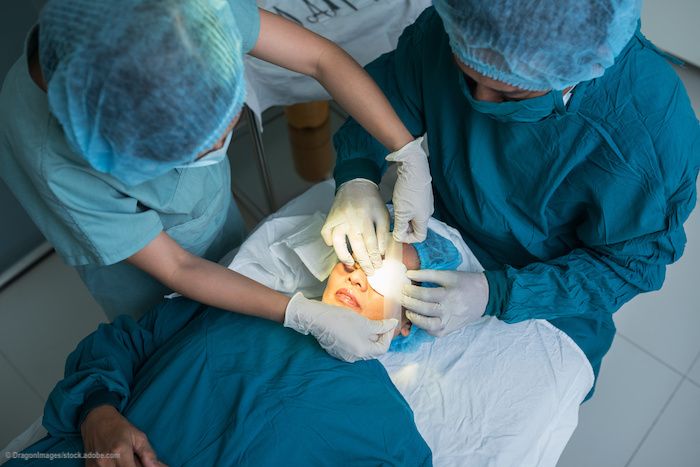Article
Retinal detachment: No time like the present or sleep on it?
Author(s):
Anatomic changes after RD might help determine best time for surgery

After detachment, development of cystoid macular edema and retinal degeneration occur, making time a key element in treatment.
Reviewed by Kirk H. Packo, MD
Timing is everything, even in relation to how quickly retinal detachments (RDs) should be repaired. But what factors go into determining the optimal surgical time? A look at the anatomic changes that ensue after RD might help answer that question, according to Kirk Packo, MD, professor and chairman, Department of Ophthalmology, Rush University Medical Center, Chicago.
Anatomic changes
A cascade of events takes place after a detachment, the first of which is development of cystoid macular edema followed by retinal degeneration.
A study of owl monkeys showed that two variables were recognized over time: the time and height of the detachment. The photoreceptors begin to change within a day of the detachment. They fragment, become irregular, and rupture. The cells die within 14 days, Dr. Packo said.
Although the RPE have their normal blood supply under a detachment, they also are affected. The retinal pigment epithelium (RPE) microvilli retract and the surface becomes rounded.
“If the retina is put back in place, time is required for recovery,” he said. When the retina is reattached, the edema begins to resolve at one day in the owl monkey.
However, the outer segments and RPE take more time. Dr. Packo demonstrated that in cats the rhodopsin antibody is seen throughout the retina 28 days after a detachment.
The bipolar cells begin to sprout, and Mueller cells proliferate at three days, which becomes marked by the seventh day. By 28 days, a glial scar has formed throughout the inner retina, which explains the lack of visual recovery, Dr. Packo pointed out. In the outer segments, change happens fast, i.e., within an hour, and they shorten considerably over time. By 28 days after reattachment, they have still not normalized.What to look for
There are preoperative factors that determine retinal recovery in humans.
Duration: Ross et al. (Ophthalmology. 1998;105:2149-53) compared the durations of macula-off RDs in groups treated surgically one to two days, three to four days, and five to seven days after detachments. Interestingly, the vision in the three groups was a mean of 20/60 (p = 0.5) (mean follow-up, 10.5 months), suggesting that repairing a macula-off detachment within seven days does not affect the final vision. Another study (Ophthalmology. 2002;109:146-56) looked at postponing surgery for more than one week (range, one day to six weeks) in 94 cases of macula-off detachments.
The investigators found that the best results were achieved within 10 days of the detachment and younger patients fared better. The vision at 11 days to six weeks was 20/40 in 27% of cases compared with 20/40 in 71% at 10 days or sooner and 20/40 in 14% after six weeks after the detachment, Dr. Packo noted. “The results indicate that there should really be no rush to the operating room,” he said.
Height: A study (Retina. 2005;25:434-53) of 20 cases with a macula-off detachment reported the final vision was correlated negatively with height, distance from the fovea to the closest attached retina, and the extent of structural changes in the detached retina.
The authors found a significant difference at nine months in vision between shallow and highly detached cases, 20/40 and 20/63, respectively.
Technique: Among the three techniques for treating detachments, pneumatic retinopexy, buckling, and vitrectomy, a comparison of the first two showed identical results, 98% and 99% overall success, respectively (Ophthalmology. 1989;96:772-83). In cases of macula-off detachments pneumatic retinopexy achieved a vision of 20/50 in 80% compared with 56%.Making a comparison
When vitrectomy and buckling were compared (Retina. 2005;25:957-64), no differences in anatomic success or vision were found (83% versus 94% and 20/45 versus 20/40, respectively). Another study (Jpn J Ophthalmol. 2000;44:538-49) also reported that the two procedures were equivalent; however, in vitrectomy patients with macula-off detachments longer than one week vitrectomy achieved better results than buckling.
Buckling stills holds its own as evidenced by the PRO Study that included 2,168 cases of uncomplicated RDs; phakic patients achieved better vision with buckling versus vitrectomy or vit/buckle, and in pseudophakic patients had higher single-surgery success with buckling compared with the other two.
Other factors are persistent fluid and macular displacement. The former can take up to two years to resorb but final vision is unaffected if the RD is shallow. Unintentional retinal displacement with resulting ghosting of vision was reported to be related to the RD extent and how much of the macula was unattached.
Non-surgical enhancement of macular recovery can prevent apoptosis via hyperbaric oxygen; neuroprotective drugs, and anti-apoptotic drugs, such as bromodine (Alphagan, Allergan).
Some surgeons advocate using bromodine instilled frequently to theoretically prevent apoptosis in a patient with a total RD. This unproven methodology could help preserve better photoreceptor function during any delay of surgery.
For patients in whom the fovea is attached, a study compared immediate surgery with surgery at three days after detachment, finding no difference in the final outcomes (Am J Ophthalmol. 2010;150:201-10).
Bilateral patching is possible. Positioning the patient preop is also an “urban legend” of surgeons to prevent foveal detachment while waiting to get the patient into the OR. Some surgeons advise patients to maintain a position on their side and avoid reading.
Dr. Packo concluded that if the surgery is delayed and the patient has a poor outcome, they may question the delay and the activities. Injecting a bubble is an option that might flatten the macula, although negotiating around the bubble is difficult during buckling. Removing the bubble during vitrectomy can negatively affect the lens.
Disclosures:
Kirk H. Packo, MD
E: kirk_packo@rush.edu
Dr. Packo has no financial interest in any aspect of this report.
Newsletter
Don’t miss out—get Ophthalmology Times updates on the latest clinical advancements and expert interviews, straight to your inbox.




